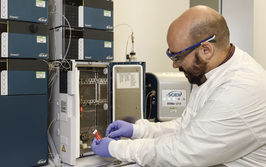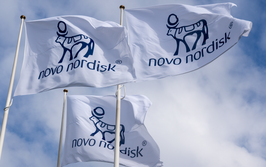Keep Your Eye on the Supply
Almost a quarter of the way through the 21st century, it is hard to believe – and even harder to accept – that the deaths of children can be attributed to cough medicines manufactured with substandard excipients. IPEC Federation is clear: all stakeholders must not suffer complacency when it comes to supply chains.
Stephanie Vine | | 10 min read | Interview

Credit: Interviewee supplied
In January 2023, the World Health Organization (WHO) issued an urgent call about the dangers of contaminated cough medicines, following the deaths of children in Gambia, Indonesia, and other countries. Certain cough medicines were found to contain diethylene glycol (DEG) or ethylene glycol (EG) – both of which are toxic to humans. WHO does not believe these are isolated incidents and has called for “key stakeholders engaged in the medical supply chain to take immediate and coordinated action.”
For regulators and governments, this call to action means detecting and removing substandard products from circulation, assigning resources for risk-based inspections of pharmaceutical manufacturers, increasing market surveillance, and taking any necessary enforcement action. For medicine makers, it means purchasing pharmaceutical grade excipients from qualified suppliers, including distributors, conducting testing, providing assurance of quality, and keeping records to facilitate supply chain traceability. Suppliers also have a role to play in checking for evidence of falsification, keeping correct records, and ensuring they only sell or distribute products to approved sources.
Incidents of DEG poisoning are not new. The first incident was reported in 1937 in the US, when a company in Tennessee manufactured sulfanilamide dissolved with DEG. Various other cases have emerged over the years, with a spate of deaths in the 1990s leading industry stakeholders – such as WHO and IPEC – to develop guideline documents helping to ensure the security of the supply chain and protecting patients.
In light of recent incidents, IPEC Federation says it will revisit and update its guidelines. Here, we speak with Dr. Frank Milek, former President of the association who has remained involved in IPEC for more than 25 years.
How did the IPEC Federation get involved with supply chain security for excipients?
WHO got involved in the question of supply chain security of excipients in the 1990s after a high-profile incident in Haiti involving DEG-contaminated glycerol; IPEC also got involved at this time. Back then, there was no IPEC Federation, but there were three regional IPECs: IPEC-Americas, IPEC Europe, and IPEC Japan. WHO’s headquarters are in Geneva, so IPEC Europe was the main point of contact and represented all three IPECs. We were asked by WHO to give our opinions on the root cause of the incident and to provide suggestions. IPEC Europe identified the need for a focus on the supply chain of excipients, particularly given their high diversity.
Examples of Tragedy
Haiti: 1995–1996
In Haiti from November 1995 to June 1996, 86 children were diagnosed with acute anuric renal failure. Most did not survive. A report found that DEG-contaminated glycerin, imported from another country, had been used to manufacture acetaminophen syrups, which the children had consumed.
Panama: 2007
In 2006, a physician in Panama noted a number of patients with unexplained acute renal failure. The cause was later found to be cough syrups contaminated with diethylene glycol. At least 100 people died, but some claim that the number could be significantly higher. Glycerine used to produce the syrup had reportedly been labelled as 99.5 percent pure and had arrived in Panama via a network of distributors. Over the course of the supply chain, the glycerine was not tested, and the certificate of authenticity was altered. The glycerine was found to have originated from China, where it was originally labelled as “TD glycerine.” Nobody questioned what this meant at the time, but it is believed to stand for “tidai” which means “substitute.”
A number of individuals were sent to prison in Panama in 2016.
What led the IPEC Federation to update its position paper on supply chain security for excipients?
In 2003, WHO published the Good Trade and Distribution Practices for Pharmaceutical Starting Materials, and in 2006, IPEC-Americas and IPEC Europe jointly published the Good Distribution Guide for Pharmaceutical Excipients (later revised and re-published by the IPEC Federation in 2017), which was the outcome of the collaboration with WHO. The Guide was intended to help all stakeholders in the global supply chain for pharmaceutical excipients to improve safety and avoid contamination cases. Guidelines are not the same as regulations, so we also developed a position paper to explain why we thought it was important to use the guide.
After we published the guidelines and position paper, the number of incidents caused by DEG contamination seemed to come down for 10 years. Recently, however, cases have started to appear again – and we can see that the root causes of today’s cases are likely similar to the earlier cases. We engaged with WHO to discuss the situation and what support we can offer. From these discussions, we decided to update our position paper to reinforce our opinion on how to safely manage excipient supply chains.
Points for Consideration
The IPEC Federation position paper states that pharma manufacturers should consider the following:
“Awareness and robust application of guides, standards and regulatory requirements
Starting materials to be purchased from qualified and approved suppliers
Purchase of ingredients suitable for use in pharmaceutical products/pharmaceutical grade excipients, no use of industrial grade chemicals as pharmaceutical excipients
Robust incoming goods inspection, quality control testing and product release according to applicable monographs or equivalent validated and appropriate internal method(s)
Full traceability of the supply chain back to the original excipient manufacturer
Awareness and application of Risk Management principles
Training system and records”
Additional excerpts:
“Initial findings from WHO indicate the following areas require more focus and in-depth investigation:
- Criminal activity
- Falsification of records (namely Certificates of Analysis)
- Supply Chain complexity
- Lack of, or insufficient QC testing
- Use of industrial grade material”
“IPEC Federation wishes to reemphasize the points made in the Introduction that ethylene glycol and diethylene glycol are chemicals for use in industrial applications only, such as for example, industrial solvents, coolants and antifreeze agents. Ethylene glycol and diethylene glycol are not approved for use in pharmaceutical applications. When consumed by human beings, especially young children, e.g., as components of a medicinal syrup or other liquid pharmaceutical formulations, they lead to significant toxicity effects. Depending on the dose, these effects may include severe kidney damage potentially resulting in death.”
Why do you think incidents caused by DEG contamination are again on the rise?
We believe that the good practices published in the past – and the publicity around these guidelines – have helped to prevent substandard medicines caused by substandard ingredients. Yet, it’s clear that these good practices are not always implemented properly by all companies. Perhaps some stakeholders are becoming more lenient or less cautious. We cannot say for sure why these cases are increasing – especially when the investigators in many of the cases do not always disclose details about exactly how the contamination occurred. However, we have observed that many of the cases come from environments where drugs are under price pressure, or in lower income countries where there is less regulatory oversight. In environments with less regulatory resources and scrutiny over supply chains, there are more opportunities for quality standards to be jeopardized, whether through criminal intent or lack of knowledge of best practices.
The Gambia Investigation
According to a report from the US Centers for Disease Control and Prevention, DEG-contaminated medicines are a particular threat to low income countries: “Inadequate regulatory structures make the sale of medications from international markets an especially high-risk activity in low-resource settings.”
The report was produced in response to DEG-contaminated medicines in the Gambia and stated: “A large cluster of acute kidney injury cases affecting children in The Gambia in 2022 was associated with case fatality rates >80%. The implicated syrup-based pediatric medications that had been administered to patients were imported from a single Indian manufacturer. This is one of the first documented DEG outbreaks in which contaminated medications were imported rather than being domestically manufactured.
“This likely poisoning event highlights the potential public health risks posed by the inadequate quality management of pharmaceutical exports,” says the report. “Among reports of AKI associated with DEG-contaminated medical products, this is the first in which DEG-contaminated medications were imported into a country, rather than being domestically manufactured. Inadequate regulatory structures make the sale of medications from international markets an especially high-risk activity in low-resource settings.”
CDC, “Acute Kidney Injury Among Children Likely Associated with Diethylene Glycol–Contaminated Medications — The Gambia, June–September 2022,” (2023).
The FDA has released new guidance for industry in response to the situation. How would you compare the FDA’s approach with that of WHO in terms of addressing the root cause of the incidents?
Both approaches make sense and, in combination, will help to improve the situation. It is always better to heal the problem at its root cause. WHO is still investigating the causes of recent incidents, but from there stakeholders can consider actions to systematically improve processes. With more incidents occurring, it is more important than ever before for stakeholders in the affected countries – including excipient manufacturers, finished dosage form manufacturers, wholesalers and drug sellers, and regulators – to come together and be made aware of the problems. They must know that, to resolve them, they must apply best practices and every single principle of a standard across the entire supply chain. It’s not enough to just test at the end of the supply chain to ensure quality because you can only test if you know what you are testing for. There are many opportunities in the supply chain to spoil the quality of the product, and if you don’t have the right test strategy in place, you will fail to identify the problems.
In May 2023, the FDA published guidance for industry focusing on the quality control approach and to ensure that excipients – particularly excipients at high risk of DEG contamination – are tested by pharmaceutical companies. At the IPEC Federation, we believe that this should not be the only approach. Using this approach alone will not avoid future incidents. We need both a quality control approach and good distribution practices for pharmaceutical excipients. When bringing stakeholders together, we also must do better in making arguments to convince people that they must ensure they are doing their duties at every point in the supply chain. It is not enough to agree with a supplier on the specification and basic quality of an excipient, and to receive and test that excipient before use. You must understand the supply chain. Who is involved? Who is handling the product and storing the product? What about repacking? You must understand all of this so that you can manage the risk.
Documents to Consider
WHO, “WHO Good Trade and Distribution Practices for Pharmaceutical Starting Materials” (published in 2003; updated in 2016).
IPEC Federation, “Good Distribution (GDP) Guide for pharmaceutical excipients,” (published in 2006; updated in 2017).
IPEC Federation, “Latest fatal incidents with contaminated medicinal syrup during 2022/2023 - an updated IPEC Federation Position Paper,” (2023).
FDA, Guidance for Industry, “Testing of Glycerin, Propylene Glycol, Maltitol Solution, Hydrogenated Starch Hydrolysate, Sorbitol Solution, and other High-Risk Drug Components for Diethylene Glycol and Ethylene Glycol,” (2023).
What action(s) is the IPEC Federation planning in response to the situation?
We must all remain vigilant – and know that global supply chains carry risks. Supply chains today are far more complex than in the past, and the more steps there are in a supply chain, the greater the risks of companies or individuals being able to slip in substandard materials. IPEC Federation is working on the revision of our Good Distribution Practices guideline – with publication planned for 2024. Our revised guidelines will take into account the conclusions that WHO draws from its investigations account. We are also open to cooperating with WHO if they want to involve us in their activities to improve the situation.

Making great scientific magazines isn’t just about delivering knowledge and high quality content; it’s also about packaging these in the right words to ensure that someone is truly inspired by a topic. My passion is ensuring that our authors’ expertise is presented as a seamless and enjoyable reading experience, whether in print, in digital or on social media. I’ve spent fourteen years writing and editing features for scientific and manufacturing publications, and in making this content engaging and accessible without sacrificing its scientific integrity. There is nothing better than a magazine with great content that feels great to read.



















